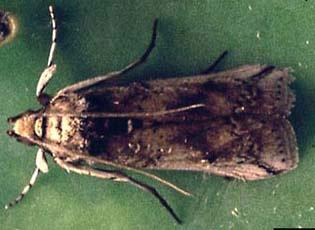Cactoblastis cactorum (Berg) (Zimmermann et al. 2004)
Cactus moth, prickly pear moth
South America (Zimmermann et al. 2004)
1989 (Johnson and Stiling 1998)
Imported to the Caribbean to control prickly pear cacti; arrived in the U.S. naturally or in cargo imported from the Caribbean (Johnson and Stiling 1998)
Feeds on prickly pear cacti (species in the genus Opuntia) (Johnson and Stiling 1998)

Cactus Moth, Adult
Photo by Dale Habeck
Find more images
Distribution / Maps / Survey Status
Federally Regulated
All Resources
Selected Resources
The section below contains highly relevant resources for this species, organized by source.
Partnership
Federal Government
State and Local Government
Academic
Johnson, D.M, and P.D. Stiling. 1998. Distribution and dispersal of Cactoblastis cactorum (Lepidoptera: Pyralidae), an exotic Opuntia-feeding moth, in Florida [PDF, 392 KB] Florida Entomologist 81(1):12-22.
Zimmermann, H., S. Bloem, and H. Klein. 2004. Biology, History, Threat, Surveillance and Control of the Cactus Moth, Cactoblastis cactorum [PDF, 1.25 MB] Vienna: International Atomic Energy Agency.
